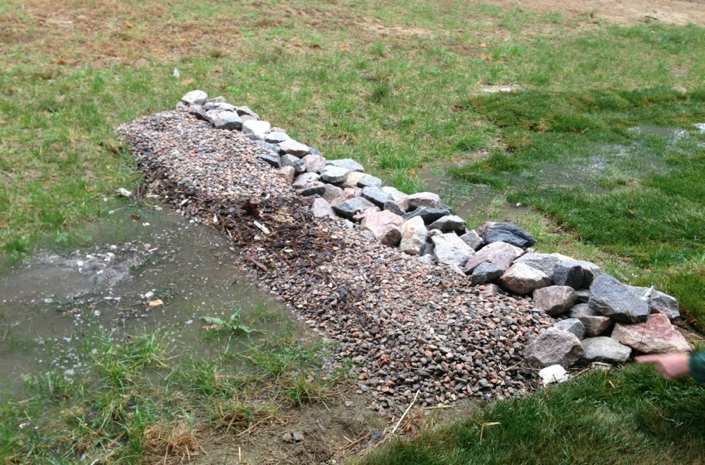Two swales (Mango Creek and I-40) treating highway runoff were retrofitted with simple check dams typically used for construction site sediment and erosion control to determine if these devices might improve post-construction stormwater management. The Mange Creek swale was retrofitted with a pair of standard rock check dams. The I-40 swale was retrofitted with a system of excelsior fiber wattle check dams and bags with proprietary phosphorus-adsorptive media (ViroPhosTM) to investigate if additional treatment for dissolved phosphorus was provided. Each swale was instrumented for approximately six months to collect data prior to the installation of check dams (pre-retrofit period) in March and April of 2014. Monitoring continued for an additional twelve months post-retrofit. Hydrologic data were collected at Mango
Creek to examine peak flow mitigation and volume reduction imparted by the check dams due to additional storage and infiltration. Flow-proportional water quality samples were obtained to investigate removal of nitrogen and phosphorus species and total suspended solids (TSS) during the pre- and post-retrofit phases of the research.

The inclusion of rock check dams in the Mango Creek swale did not significantly improve the volume reduction or peak flow mitigation of the SCM; however, these statistics were impacted substantially by the small pre-retrofit data set. Improvements were observed for volume reduction, peak flow mitigation, and hydraulic retention time, especially for small (<0.75 inch) and moderate (0.75-1.5 inch) rainfall events. Rock check dams did not significantly improve the removal rates of nutrients or TSS. However, these statistics were again impacted by the small pre-retrofit data set. Total nitrogen (TN) and total phosphorus (TP) concentrations from the highway were low compared to the literature, limiting the potential for significant reduction. Even so, TN and TP concentrations exiting the swale (0.81 mg/L and 0.13 mg/L, respectively) remained low and generally met “good” water quality conditions based on ambient stream health. Rock check dams were effective in the filtration of gross solids, which led to clogging of the check dams and degradation (due to extensive ponding) of the swale vegetation over time. Inclusion of excelsior fiber wattle check dams at I-40 did not significantly improve any pollutant event mean concentrations (EMCs) compared to pre-retrofit conditions. The ViroPhosTM media amendments did not significantly improve the treatment of O-PO43- in the swale relative to pre-retrofit conditions. Due to their high permeability, visual inspection during rain events showed the wattle check dams did not pond water; therefore, sedimentation was not improved. Overall, results from this study indicate rock check dams are preferable to straw wattles because they are able to pond stormwater, modestly improving swale performance.
